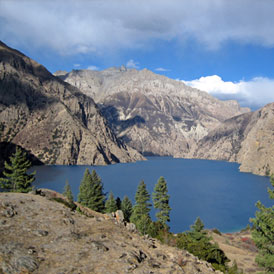Our Services
Contact Us
Climax Adventure Pvt. Ltd.
New Baneshor ( Minbhawan,34) Kathmandu, Nepal
Phone: +977 9841875014, 9741070619
Email: [email protected]
[email protected]
Website: www.climaxadventure.com
Lower Dolpo Shey and Phoksundo Lake Trekking - 25 DAYS
 Nepal’s Himalayas magnetize thousands of visitors each year since first opening up to outsiders in the fiftes. Khumbu (Everest), Langtang, Annapurna Sanctuary, Mustang and the Lo (Upper Mustang also referred to as Lo Manthang) are well-liked destinations. While the areas have long developed as popular trekking routes, Nepal’s Western Himalayas are gradually emerging as a delightful destination for adventure and ethno-cultural tourism. Dolpa (Dolpo in Tibetan) is one such destination offering a diverse nature and a rich culture and lifestyle of over 5000 years.
Nepal’s Himalayas magnetize thousands of visitors each year since first opening up to outsiders in the fiftes. Khumbu (Everest), Langtang, Annapurna Sanctuary, Mustang and the Lo (Upper Mustang also referred to as Lo Manthang) are well-liked destinations. While the areas have long developed as popular trekking routes, Nepal’s Western Himalayas are gradually emerging as a delightful destination for adventure and ethno-cultural tourism. Dolpa (Dolpo in Tibetan) is one such destination offering a diverse nature and a rich culture and lifestyle of over 5000 years.
The district of Dolpa is situated in the mid western region of Nepal. At an elevation range of 2700-7000 meters, the Nepal’s Western Himalayas traverses Dolpa distinctly resulting in Upper/Inner Dolpo, a vast arid stretch resembling the topography of Tibetan plateau and Lower Dolpo, a semi arid topography with deep gullies and narrow valleys. Mountains and rock formations cover over half of Dolpo’s topography leaving a sparse forest cover mainly of Pine, Oak, Birches, Cypress, Walnut, Bamboo, and Maple. Snow fed rivulets run down the high mountains but only larger torrents are perennial. Bheri, Suli, Pungmo are notable rivers that run through Dolpo’s narrow gullies.
In sharp contrast to its size Dolpo’s economy is frail and dependent. Its absolute disconnection from the outside world has cost Dolpolis adversely. Till this day Dolpo is far off from road connection. The high mountainous terrain makes any form of navigation difficult and to certain extent impossible. The lack of sufficient arable land affects annual food production thereby resulting in an incessant dependency on state subsidized food distribution scheme. Modern industries, trade and services are yet to implant a meaningful foothold in Dolpo. As grim a picture this may portray, Dolpo is actually quite rich. Besides universal water resource, it is bestowed with bountiful precious herbs and mineral deposits. In only last decade, Yarshagumba -a semi worm, semi fungi abundantly found in the alpine altitude– emerged as a single dominant lucrative item of trade. Similarly, Silajit, a mineral with multi therapeutic value extensively used in Tibetan medicine, is also widely harvested in the overhanging cliffs of Dolpo.
Dolpo’s attraction is its rich religious and cultural heritage, thousands years history inherited from the ancestors. In Upper Dolpo’s vast arid land bordering China live some of Dolpo’s indigenous people with close cultural, linguistic, and racial resemblance to the people of Western Tibet. These people have lived in Dolpo for almost 4000 years preserving the early Tibetan Buddhist teachings and rituals till this day.
Buddhism is the main religion in Dolpo. The monasteries in Shey and Tsakang are two significant sites of pilgrim in this part of the Himalayas. The Crystal Mountain in the same region is considered holy by the people of Dolpo who believe in acquiring divine merit if circumambulated once in a lifetime. The teachings and practices of Buddhism in Dolpo grew even further after the Chinese takeover of Tibet in 1949. The fleeing Tibetans including venerable Lamas crossed through Dolpo taking refuge at its many monasteries and towns scattered over the vast arid landscape. Some contemporary Rinpoches of different sects of Tibetan Buddhism were actually born in Dolpo to fleeing Tibetans. Buddhism continues to be a way of life in upper Dolpo; and till today young boys sent to places as far as Mysore in South India to study Buddhism under the tutelage of venerable Lamas.
Interestingly, Upper Dolpo was once a part of the Kingdom of B’od in Western Tibet. B’on, the religion of the land with close semblance to Buddhism, is still practiced in certain pockets of Dolpo. B’on and Buddhism differ on fundamental ritual practice and inscription. In Ringmo, a B’on village nestled in southern end of Shey-Phoksundo Lake, the Chorten – typically a Stupa erected at the village entrance- is always kept at left while making an entry into the village in sharp contrast to reverse practice in Buddhism. Similarly, the inscription of Swastika symbol is reversed in B’on tradition. The arcane differences apart what is interesting is the co-existence of the two for thousands years to this day.
Trekking in Dolpo is an enriching experience. The newer routes either originating or terminating in Dunai, the district headquarter, has helped raise the number of trekkers flocking in to experience Dolpo’s rich nature and ancient religious traditions.Dolpo’s scattered habitation and strenuous terrain strictly demands camping treks. Teahouses, conveniently found in other trekking destinations, are either non-existent or are in a primitive stage of development in Dolpo. Trekking groups carry all food and necessary supplies to last for the entire trip. Caravan of ponies, yaks and porters is a common sight along the narrow trails of Dolpo in early fall and late spring each year when most trekking related activities take place.
Today, Upper Dolpo route originating or terminating in Jomsom, Dolpo Circuit, Dolpo-Mugu-Jumla trail, and Shey Phoksundo are the most popular trekking destinations. Needless to mention that many of these trails remains unused during snowy winter and torrential monsoon resulting in often dilapidated state of the trail and logwood crossovers. The trekking duration ranges anywhere from 9-31 days. A lengthier and customized route beginning in Jomsom through Upper Dolpo, Mugu and Jumla can also be tailored for adventure seekers and Buddhism enthusiasts preferring to undertake an extra stretch to experience Dolpo with Climax Adventure. We are the classic adventure operator agency in Nepal Himalayas.
Trip day to day itinerary
Day 01: Arrive Kathmandu & transfer to hotel.
Day 02: Sightseeing tours of Boudhanath, Pashupatinath & Patan.
Day 03: Fly Kathmandu to Nepalgunj
Day 04: Fly to Jumla (2370m) & trek to Gothi Chaur (2700m)
Day 05: Trek to Naphukana (3080m)
Day 06: Trek to Chaurikot (3060m)
Day 07: Trek to Bheri Riverside (2610m)
Day 08: Trek to Garpung Khola (2900m)
Day 09: Trek to Kagmara (3500m)
Day 10: Trek to Kagmara Phedi (4000m)
Day 11: Cross Kagmara La (5115m)
Day 12: Trek to Pungmo
Day 13: Trek to Phoksundo Lake
Day 14: At Phoksundo Lake
Day 15: Trek to Baga La Phedi
Day 16: Cross Baga La (5090m) trek to Numa La Phedi (4800m)
Day 17: Cross Numa La (5360m) and trek to Do (4100m)
Day 18: Resttime
Day 19: Resttime
Day 20: Trek to Lahini (3560m)
Day 21: Trek to Tarakot (2600m)
Day 22: Trek to Dunai (2100m)
Day 23: Trek to Juphal (2500)
Day 24: Fly Juphai/Nepalgunj/Kathmandu
Day 25: Depart Kathmandu

